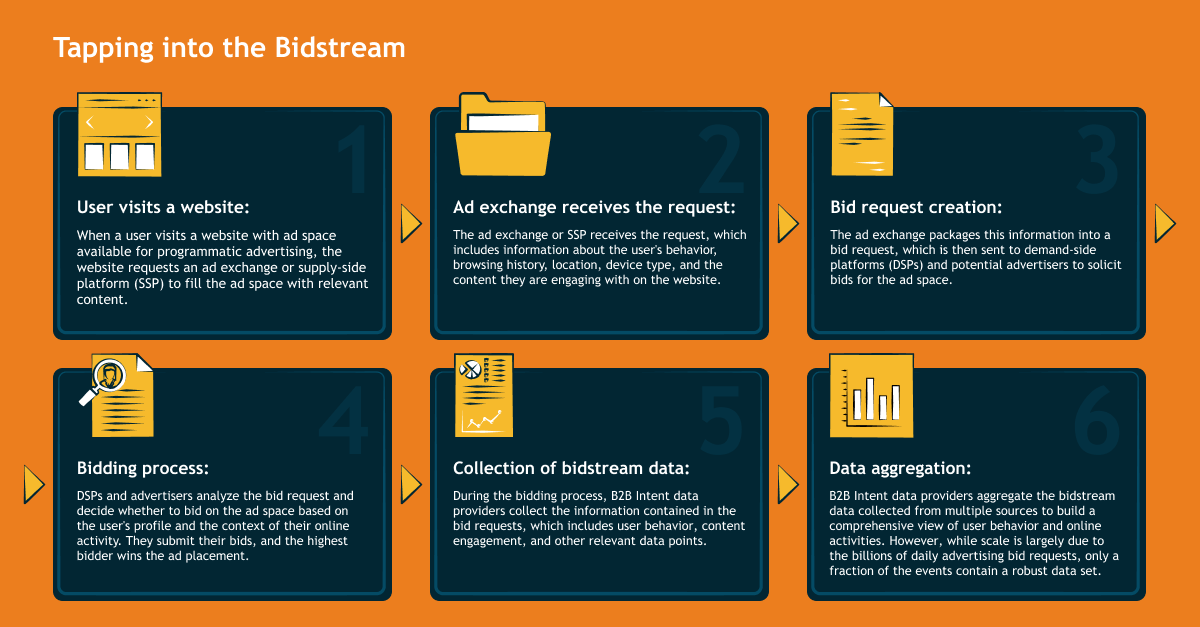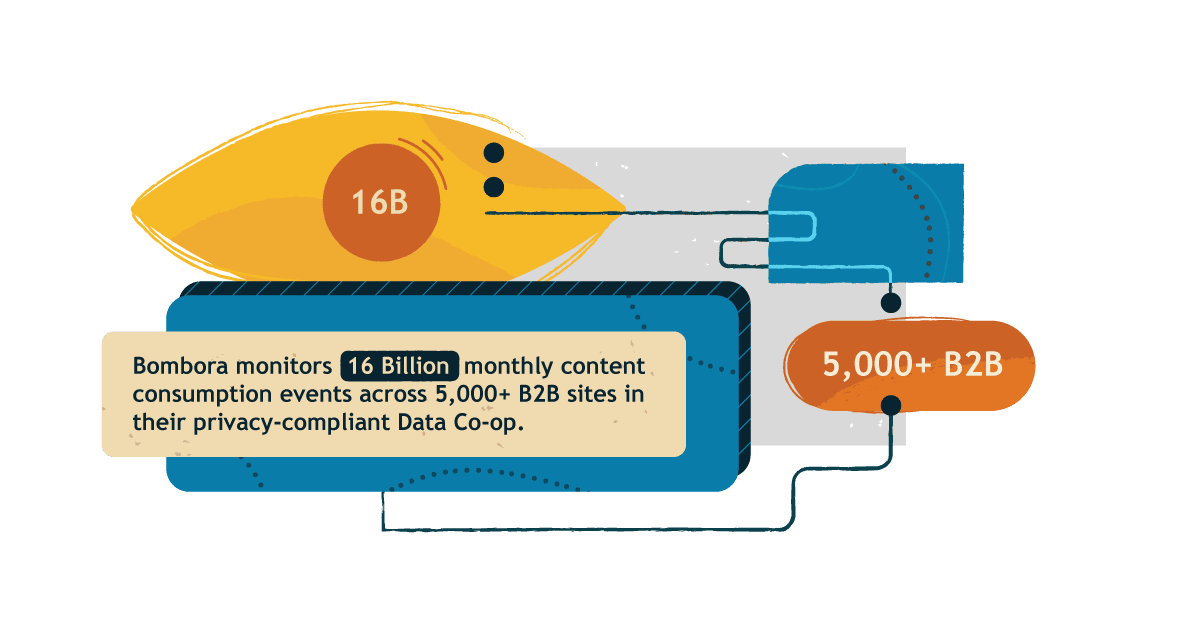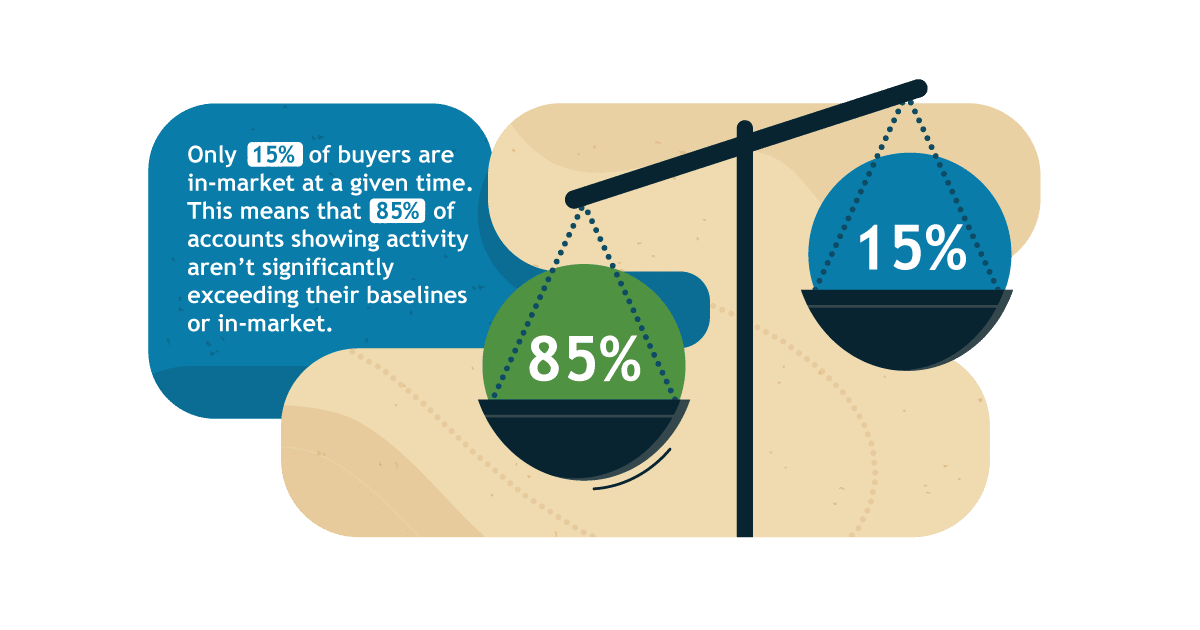5 ways to make your B2B marketing more personalized, sustainable, and downright effective
- 1 Personalization as an account-based marketing strategy for sales and marketing teams
- 2 1. Use personalized email marketing
- 3 How email marketing personalization can boost lead generation
- 4 2. Sustainable digital advertising
- 5 Is all third-party Intent data the same?
- 6 2-3x CTR on LinkedIn ads?!
- 7 3. Relevant, full-funnel content marketing
- 8 Be there for your prospects when they need you most
- 9 4. Powerful social media outreach
- 10 The right audience, every time
- 11 5. How marketing teams can champion lead scoring with Intent
- 12 Looking to get started with lead scoring?
Hi {FirstName},
Let’s talk B2B personalization. (By the way, who hasn’t read an email personalized with their first name before?)
The concept of personalization in account-based marketing isn’t new — it’s been a buzzword since the early 2000s when marketing teams started incorporating potential customers’ names into emails to boost lead generation.
Back then, it was little more than a glorified mail merge. Today, we have everything from highly integrated marketing automation providers to machine learning-based recommender systems that can tell what your favorite brand of socks is and recommend the next movie you should watch.
In total, the global personalization technology market is estimated to reach a hefty $2.72 billion by 2027, and, while B2C has been at the forefront of personalized communication for decades, effective personalized marketing is just starting to make its way into B2B marketing strategies.
Personalization as an account-based marketing strategy for sales and marketing teams
For B2C, the case to create personalized content was easy.
As Dale Carnegie famously said, “A person’s name is to that person, the sweetest and most important sound in any language.” If you knew what type of products people were interested in — and you were able to get those products in front of that person — you’d likely end up boosting your conversion rate.
But, for enterprise companies, the benefits seemed less obvious at first.
Typically, B2B sellers have a smaller number of custom solutions than their B2C kin, and the entire journey of the B2B buying cycle is much more complex than just clicking “Buy Now,” so what’s the big advantage of personalizing our outreach?
For starters, the data sources we’re able to collect from potential customers have grown substantially.
Whereas we used to only have access to the information website visitors put into a form or the basic demographic or firmographic fields from a purchased list, we now have access to rich first- and third-party data, which not only shows information about an actual person or customer segment but also gives strong indications of the motivations and interests that speak to specific pain points. It also provides a deeper understanding of the buyer Intent of high-value prospects via specific content they’ve interacted with online.
Secondly, the average B2B buying committee has been steadily increasing in size and now consists of 6-10 different stakeholders, each with their own unique motivations and perspectives that need to be individually addressed to move the account through the sales pipeline.
Thirdly, while personalization has been typically used with a focus on increased sales (which it does very well), there’s another benefit to the sales team in knowing individual buyers that’s quite often overlooked — and that’s called marketing sustainability.
Sustainable marketing?
While the goal of implementing personalization with your target market is to understand who a person is and what they want or are interested in, we can also use the same personalization tools to understand what someone isn’t interested in and direct our sales efforts appropriately.
For example, if sales and marketing teams know from collecting Intent data that a prospect is showing strong interest in our solution and is likely to convert, they can prioritize outreach and marketing spend accordingly to move that account closer to the sales funnel.
Conversely, if we know an account is not showing any Intent signals or interest in our product, we can save the effort and expense of putting excessive advertising and SDR hours into that account.
Therefore, marketing sustainability is really about efficiency — it means spending the majority of our time, money, and effort on qualified leads that are most likely to convert. It also means not burning out potential future customers by pushing our ads in front of them when they’re not yet interested in what we have to offer.
Okay, now that we’ve discussed some of the benefits personalization can offer our B2B marketing strategies (understanding our individual buyers’ interests and motivations, speaking to stakeholders and their independent motivations, and increasing our efficiency and sustainability), let’s dive into a few tactical strategies where we can add improve personalized marketing to increase lead generation.

1. Use personalized email marketing
Personalization started with email, and it’s no wonder why — personalized emails are a great 1-to-1 medium where you can reach each of your potential customers individually in addition to your existing customers.
But, while prospects used to be impressed just by seeing their name at the top of an email, this has now become table stakes for most marketers when trying to amplify customer acquisition. With the average B2B prospect receiving 121 emails per day, we need to do much more to stand out.
Integrating Intent data into your buyer journey using email marketing will give you several advantages that will help your emails be personalized…not just look personalized.
Send emails to the prospects most likely to respond
You just sat down with your target account list…but who do you email first?
Intent data shows which accounts have been actively looking for your solution (and which haven’t). With this prioritization in hand, your SDRs can more effectively spend their time reaching out to the accounts that will be most receptive to their outreach rather than emailing accounts that aren’t interested at the moment.
Understand what your prospects are most interested in right now
Knowing who to reach out to is one thing. Knowing what to say is another thing entirely.
Intent data doesn’t just tell you that these accounts are actively in the research phase — it tells you what each account is busy researching. This means you can tailor your messaging to address each account’s individual needs instead of sending a more generic message that would likely just be ignored.
Now the content of your outreach will be more personalized and speak directly to your prospects’ needs.
How email marketing personalization can boost lead generation
Click here to see how Marketo achieved a 107% increase in email opens and a 120% increase in click-through rates using Bombora’s Company Surge® for account prioritization and topic discovery!
Reduce customer churn
Do your customers let you know when they’re thinking of leaving you for your competition?
We didn’t think so.
Sadly, most customers don’t call to let you know before they switch over to a competitor; you usually only find out after they churn. Again, Intent data will tell you what your customer is researching — even if it’s your competition.
And, by knowing if one of your customers is actively looking into your competition, you can proactively reach out with helpful, relevant information and offers to pull them back before it’s too late.
These strategies are just the tip of the iceberg. If you want to see more ways Intent data can help you personalize your email outreach and boost your open and meeting creation rates, check out our writeup here.
2. Sustainable digital advertising
Digital advertising is another battleground that’s become more and more cluttered over recent years, with modern estimates claiming that we see up to 10,000 ads per day (up from an estimated 5,000 ads per day back in 2007). As consumers, we see ads virtually everywhere, and as brands, we’re finding it harder and harder to stand out.
If we’re not careful, our advertising can become expensive with low rates of return, and it can be taxing on our audience if we send them poorly targeted ads when they’re not yet in the market for what we have to offer.
In addition to solid ad creative, using first- and third-party Intent data will help ensure you’re reaching actively interested prospects that are most likely to click and sparing accounts that aren’t quite ready for your solution.
This Intent data can also help you understand where your prospects currently reside in the funnel, so you can serve them content that will be most helpful to them at the present stage of their buying journey.
Is all third-party Intent data the same?
Using Intent data can help increase the efficiency and sustainability of your digital advertising campaigns, but using the wrong type of Intent data can get you in a heap of trouble (like violations, fines, and other compliance issues).
Co-op Intent data
Co-op Intent data is collected with permission from a group of sites that opt in to a data-sharing cooperative. These sites ensure all the browsing data is collected with consent and install a dedicated tag that assesses the content on the page so the true topic of each piece of content is classified.
Bidstream Intent data
Unlike co-op data, bidstream Intent data is scraped from websites via ads and shared on ad exchanges. Bidstream data relies on the keywords present on a page to determine Intent (vs. understanding the actual meaning of the article) and is collected without regard to user safety or privacy. General Data Protection Regulation (GDPR) compliance is questionable at best.

2-3x CTR on LinkedIn ads?!
See how Exterro realized a 2-3x increase in CTR on LinkedIn ads and uncovered new multimillion-dollar sales opportunities by integrating Bombora’s Company Surge® Intent data into their ad targeting process!

3. Relevant, full-funnel content marketing
As every good marketer does, we make great content for every stage of our customers’ buying journeys. But, with 44% of our B2B buyers identifying specific solutions before even reaching out to a salesperson, we can’t rely on our customers to directly tell us what stage of research they’re in.
How can we know what specific pieces of content we should send to each customer?
To prevent us from sending our light top-of-funnel content to buyers who are ready to make a purchasing decision (or from sending our highly technical bottom-of-funnel content to prospects who are just window shopping), we can use Intent data to understand what other topics our customers are researching and approach them with the appropriate level of content.
With this data in hand, we can send our customers the content that’s most likely to answer their questions, address their concerns, and help them on their path toward conversion.
Be there for your prospects when they need you most
“I describe it as: ‘We can hear them sneezing, and we go offer them a Kleenex.’”
— Ben Howell, Head of Demand Generation and Paid Digital, Americas, Salesforce
While most buyers don’t go on social media to see ads, social is a great place to connect with large target audiences on a personal level by catching their interest and supplying them with interesting and relevant content.
Facebook alone boasts 2.91 billion users, and you can reach them with an average cost-per-click (CPC) of $0.64. LinkedIn’s CPC is quite a bit higher ($3.49), but it boasts a 3x higher visitor-to-lead conversion rate than both Twitter and Facebook.
Our target audiences are using these platforms — the trick is to pique their interest with the limited real estate we’re given.
Aside from aesthetics (contrasting colors, carousel ads, and other tips featured in our Social and Advertising Guide), buyer Intent data can help ensure you’re building relevant audiences and providing them with meaningful content for their current stage of the buying journey.
The right audience, every time
Be sure you’re always talking to the right audience by integrating your Intent data right into our integration with LinkedIn’s Campaign Manager!
5. How marketing teams can champion lead scoring with Intent
Leads are necessary for any business to grow, but they can also be a significant drag on your SDRs’ time. Every call made or email sent to a lead who isn’t a good fit isn’t sustainable and is a waste of time and energy for both your SDR and your prospect.
For this reason, most businesses implement a lead scoring model that helps narrow down leads by applicable demographic and firmographic details. For example, if you have an expensive enterprise product, you might quickly rule out leads at businesses that have fewer than 200 employees.
But beware, just because a prospect meets your target demographic and firmographic data doesn’t mean they’re actually ready to make a purchase. In fact, our own research found that only 15% of your buyers are actively in-market at any given time.
For this reason, a good lead scoring model should also include buyer Intent data to help surface accounts that meet your ideal characteristics and show buyer intent towards your solution.
Looking to get started with lead scoring?
Look no further!
We put together this handy workbook to help you set up and maintain an effective, Intent data-infused lead scoring system!
Are you ready to boost the sustainability of your B2B marketing?
Adding buyer Intent data to your marketing mix is a surefire way to boost your personalization in a meaningful way, but it can feel a little intimidating if you haven’t used Intent data before.
If you think you’re ready to reach new levels of effectiveness through personalization with Intent data, we put together the following resources to help you get started:
- Checklist: Are you ready for Intent data?
- Blog: 12 proven steps to hit the ground running with Intent data
- Demo: Click here to test out Bombora’s Company Surge® Intent data for yourself!
Personalization is more than just putting someone’s name in an email, and, for that, we should all be grateful.


